Beauty Given By Grace:
The Biblical Prints of Sadao Watanabe
Square Halo Books $29.99 On Sale for $26.99.
I don’t know if it is wise to be so candid in my first line: I don’t know much about art. I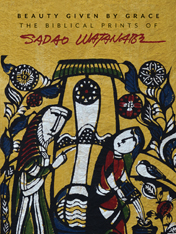 have not traveled to the great
have not traveled to the great
museums and we don’t have much good art in our own home. We have been privileged to come to know
a few artists and have sold books at conferences and gatherings of groups such as
CIVA and IAM, so we feel close to their righteous efforts. I read a lot about the interface of Christianity and
the arts and have dabbled in studying theological aesthetics; we have more books on these topics in our
small town shop than most bookstores, I guess, and we have several big lists about Christianity and the arts at our website. (See, here, for instance, or here or here.)
But I am not schooled in the arts and not very experienced.
I don’t need to write much to convince the well-schooled art experts about the value of this stunning
new book featuring the brilliant work of the late Japanese print maker, Sadao Watanabe, as they already know of him and how impressive a new book about him must be. The soon to launch
traveling exhibit which inspired this book, curated by Sandra Bowden and
sponsored by CIVA, is getting some good publicity, and the Mr. Watanabe
is, perhaps curiously, known all
over the world. (His Bible scenes,
portrayed in traditional Japanese folk art prints, are displayed in the
Vatican, and have been in the White House; a large collection is housed at
Valiparaso University* and the World Council of Churches commissioned pieces
for their headquarters. Many of the world’s finest museums show is work. His art
has graced book covers and his calendars are in homes wherever Japanese people
have immigrated.)
*For those in the mid-West, the Brauer Museum of Art at Valiparaso University is also hosting this Fall an exhibit of their own large collection of Watanabe works.)
I am more interested,
however, in promoting this good book among those who may be unsure if it is a necessary purchase for them (given the long wish-lists and short budgets so many of us have.) I’m eager to help persuade people who are…well, people like me, who are not terribly
well-schooled in the arts, to see the immeasurable value of this wonderful book,
and to invite you to celebrate (and assist) the publisher Square Halo Books in getting
this work to a broader audience.
It is, I want to announce, one of the great (if under the best-seller radar) publishing events of the year.
That I sat outdoors at a nearby cafe and, embarrassed, quickly wiped
tears from my cheeks as I read, is some indication of my profound gratitude that a book
like this exists, and that we are privileged to sell it. I hope you can share my joy in honoring this faithful
Christian culture-maker, the story and work of a man who came to Christian faith amidst the ugliness of
World War II and the grim post-war years. He was baptized at age 17 after considerable investigation and internal struggle, and, once committed to Christ, offered his
talents and gifts to God for the next 60+ years.
The book title itself is rich with meaning, beyond the obvious. Beauty Given By Grace is a line from one of Wantanabe’s early teachers, an intellectual mentor to a movement of Japanese print makers who founded an influential arts journal, uniting Buddhist principles of art, but often citing the West’s best spiritual traditions, the likes of Thomas Aquinas or even William Blake. It was this “people’s philosopher,” Soetsu Yanagi, who wanted to recover “beauty in common things” and who called Wantanabe to a deep
humility and spiritual sensitivity, away from fame or the industrial/production
workshop methods.
This 111-page, 9″ x 12″ book is mostly a collection of brightly colored, intriguing,
allusive
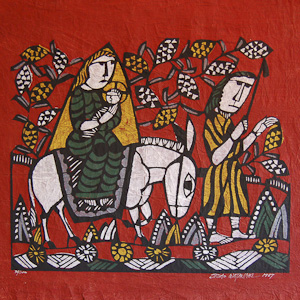 curious, (even funny, at
curious, (even funny, at
times) Bible pictures. As a
coffee-table type art book, it excels—great printing, glossy paper, expertly
designed and arranged with color on every page! It will be a lovely addition to your end-table stack (and as I suggested last year with the fabulous Art That Tells a Story compiled by Chris Brewer) it will surely be a fruitful conversation starter for guests in your home or office. Yet, it is more than an intriguing, handsome, art book, as there are four
well-written, informative, inspiring essays scattered throughout the book.
The artwork, as we’ve
said, mostly portrays Bible episodes, and the designers helpfully chose to arrange
the prints not chronologically (not showcasing the artist’s oeuvre as it grew over the more than
half a century he worked) but rather corresponding to the Biblical chronology, showing artworks illuminating passages from
Genesis to Revelation. A few
pieces were purchased specifically to fill in a few vacancies in their
collection, assuring attendees at the show and readers of the book a truly helpful visual
Bible, with over 50 artworks, and their corresponding Bible texts, capturing the unfolding drama of promise and deliverance, from creation to new creation.
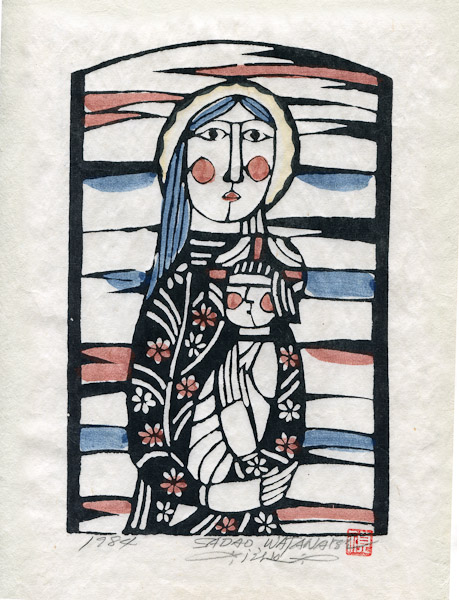 Families could use this, I’d think, in creative family devotions. Some
Families could use this, I’d think, in creative family devotions. Some
readers might find it helpful in their prayerful lectio divina practices; resourceful church
educators will find it invaluable.
If it included only these colorful, playful, moving, depictions of Bible
stories, it would be well worth the reasonable cost–we need good and creative
art to help us see things anew, and who among us doesn’t need some
right-brained help in hearing God as we see His Word? But there is more here, much more. There is plenty for devout art lovers, certainly, but I think especially for us who
don’t know much about the details of the international art world. This book will expand your horizon and, as C.S. Lewis put it, “baptize your imagination.”
The four essays in Beauty
Given By Grace are excellent, informative and inspiring. What joy to get an
inside glimpse into the life of a quiet Christian artist and those who collect
and promote his work. Included
first is a fabulous introduction to the traveling CIVA Exhibition project told with insight and
enthusiasm by Sandra Bowden (who has one of the finest collections of
Biblically-informed art in North America.
She has been a leader in CIVA, a trustee of the MOBiA, the Museum of
Biblical Art, and a generous supporter of many of the best recent initiatives for
faith-based creatives.) Bowden tells fascinating stories of Watanabe’s work,
compares him with the French Catholic painter George Rouault, and tells us
about Wantanabe’s only private student. She mentions his large Last Supper piece,
found in a church in Schenectady, and, later, takes us to the massive (and
only) stained glass installation done by Watanabe, a part of the sanctuary of
Westminster Presbyterian Church in Grand Rapids, Michigan. The 1987 stained
glass work, more than 12 feet long, is called The Covenant Window and was
fabricated by Willet Hauser Architectural Glass, Inc. of Philadelphia.
This opening chapter is so very
interesting and informative, one cannot be feel graced, knowing that there are
people like Ms Bowden who offers pieces from her own collection, and gets things like this done. She initiates and networks, promotes and shares, teaches and tells
of the many good things that art and artists can do and that back-story itself should energize us. I have read this chapter more than once and am moved, made
glad, and feel a bit better for knowing about her curating and promoting of this
humble Japanese Bible artist.
Why?
Maybe it is this: we hear about so much bad stuff done in the name of Christ — religious
work that is manipulative, Christian art that is bad, political efforts that are contentious, preachers that are creepy, authors that are crude. And in my own life I discern shallowness and boredom and
despair (it is easy to point the finger at religious knuckleheads, but my own heart and lifestyle, well….you know.) So I rejoice in the decent hope
that this book represents, the legacy left to us by the likes of Sadao, the efforts of Ms
Bowden, the organizational witness of CIVA, the publishing projects of Square
Halo, all witnesses of beauty truly given by God’s great grace. May it please Him that this book be
bought and used, shared and discussed, that we all might resist the worst of
our religion, and enhance the best of it.
Yes, that is it: this book and all it stands for gives me hope! I believe it is hope you may need, too. Am I
right?
Well, these four chapters are
good, even if they aren’t trying to be spectacular — they examine and point to the artist and his work, after all. But they are good.
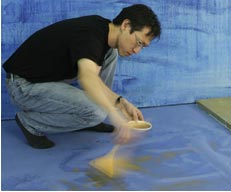 There is a deeply
There is a deeply
poignant piece by the contemporary Japanese-American artist (whose work is, in
fact, grounded in another traditional Japanese style of painting) Makoto
Fujimura. How touching to hear
Mako tell of his own boyhood studies in Japan, his return there as a graduate
student to study art and begin his career, his involvement in a campus para-church fellowship group, and
his own struggle to find his own artistic voice, wanting to honor his ethnic and cultural background and his own new-found evangelical faith. His chapter is entitled “My Journey With an Artist I Never
Met” and is a tender, honest piece for artists or fans. Or any of us, really: we all must walk
that road, don’t we, journeying alongside heroes and mentors—some whom we’ve never actually met—grounded in our
place and ethnicity, and yet wanting the gospel to seep through in beauty and
truth as we take up our vocations in the world. Fujimura’s chapter is an example
of the kind of thoughtful and faithful memoir that sounds a bit like testimony.
The longest and most
substantial essay is written by John A. Kohan. Kohan is perhaps the world’s leading scholar on Sadao
Watanabe and his chapter serves to tell us more about Watanabe’s background,
conversion, his interesting and circuitous route in finding tools and mediums that
allowed him to bring Biblical insight and narratives naturally to his countryman.
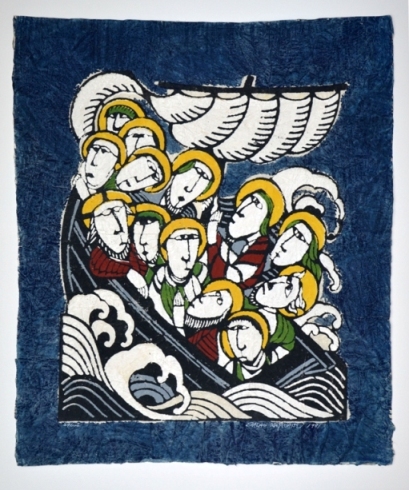
story that speaks volumes, it is told that Watanabe went into a Christian
bookstore in Japan shortly after his conversion. The book-covers, he noted, were often poorly designed, or
had exclusively Western art. He
had a passion to find ways to show forth the gospel and capture the energy,
emotion, and sensibilities of Asian culture. Without having the serious missiological vocabulary, the young Japanese artist understood incarnation and
contextualization. (A 1980 print,
one of the few that are not Bible scenes, is called The Padres Are Coming and
shows the ambiguities of Western religious colonization.)
Kohan obviously cares for
Watanabe and explains his body of work well, by telling us about his
marriage, his studies, his artistic teacher and mentors, a bit about how he
created these stunning prints. The process, which you will enjoy learning about,
is related to katazome, the ancient ways Okinawan artisans created print blocks
for cloth, especially for kimonos. Watanabe was, in this sense, a folk artist,
developing skills in an age-old trade, developing his craft, and allowing fresh
winds of creative grace to blow through his innovations in the use of paint and
color on the kappazuri prints. All
natural methods were used, of course, including using paper made from the fibrous bark of the paper mulberry tree grown by farmers in northern Japan. Read this amazing description. Persimmon tannin??
His shibugami (stencil paper) consisted
of three-ply sheets of kozo paper, hardened with persimmon tannin, then dried
and cured in a smokehouse, which gave it a brown coloring. The small-format
prints were made on plain mulberry paper known simply as washi. Watanabe preferred the textured look of
momigami (wrinkled paper) for his folio-sized stencil art. Momigami is a type of paper once used
for lining clothes, coated on both sides in konyaku (devil’s tongue root), a
gelatinous ingredient in Japanese cooking, which gives the paper strength and
flexibility. The treated sheets
are kneaded, crumpled, rolled, and stretched to create a creased, textured
surface. Wantanabe hand-painted
his momigami sheets before applying the stencil patterns, using solid colors
with occasional variegated lines.
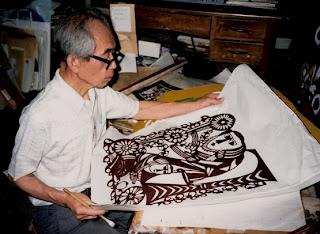 Kohan tells us a lot
Kohan tells us a lot
about the artistic vision and meaning of Watanabe’s work, (and explains why
James Michener’s explanation of the meaning of a 1960 piece, Listening, is
surely wrong) but these details about the doing of the craft are equally fabulous to read. I found his telling utterly
absorbing, creating a real appreciation for the dedication of artists who do
these kinds of things–curing paper in a smokehouse!—with such patience and integrity, slowly getting the
whole process right, working hard with hidden treasures buried within God’s creation. One story
tells how Watanabe had to learn how the natural color pigments were (or were
not) absorbed by the handmade paper.
We learn about the protein in the milky binder his wife Harue prepared
from soybean dripping and how it helped fix the color to the paper. And the ingredients!
Black was made from pure carbon and
white from crushed seashells. Red
came from the pulverized bodies of the female cochineal, a cactus-feeding
insect, and blue came from the leaves of the indigo plant. Wantanabe’s favorite color was king’s
yellow, made from the mineral orpiment, containing arsenic trisulfide. This beautiful but poisonous pigment
has proved the least stable of Watanabe’s natural colors; older momigami prints
with yellow backgrounds often show signs of fading.
Perhaps most interesting
to some theologically-minded readers will be the chapter written by I. John
Hesselink, emeritus professor of Systematic Theology at Western Theological
Seminary in Holland, Michigan (where he served as President from 1973 to
1985.) Hesselink studied under
Karl Barth in Basel, and discerned a call to teach Reformed theology in Japan. He and his wife moved there as missionaries for the Reformed Church of America (RCA)
in 1953 where they studied the language, until they returned to Switzerland to complete his PhD studies. They then moved back to Japan in
1961. Providentially, while
getting a Japanese wood block print framed near his home in Tokyo, Hesselink overheard the non-English
speaking framer/gallery owner struggling to serve a US customer;
after offering his informal translation help, the frame shop/gallery owner
“hired” Hesselink to translate for showings and lectures at his shop, paying
him in art pieces. So began Hesselink’s immersion in the
Japanese art world and, soon, a life-long friendship with the up-and-coming
young Christian artist whose Bible scenes were so very striking.
(Included in the book, by
the way, is a rare piece that Watanabe was commissioned to do in his unique
style—a portrait of John Calvin!
Hesselink was part of a commission doing translation work, painstakingly
translating Calvin’s writings into Japanese, and Watanabe’s portrait graced their
offices.)
Hesselink tells wonderful
stories about the workspace in Watanabe’s home, and his partnership with his
wife and children. “It is
amazing,” he writes, “that he could be so effective and productive, given the
crowded conditions in which he and his wife worked. I don’t think they ever took
a vacation. Except for Sunday
when they went to church, they spent all their time fulfilling their calling:
making prints that could serve as a witness to the gospel.”
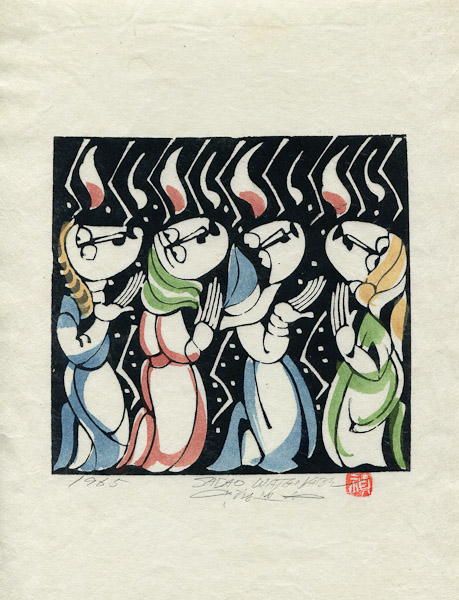
As I
got to know Watanabe better, I would occasionally suggest biblical subjects to
him that he had not yet covered. He
respected me as a theological professor, but I don’t think he ever followed my
suggestions in his artwork. He
knew the Bible very well and was not about to let anyone tell him what biblical
scenes his art should portray.
His quiet self-confidence in what he was doing, however, was not a sign
of arrogance – he was one of the most humble men I have ever known – but was
born of the conviction that he was an instrument of God and that whatever he
was able to accomplish was through the grace of God.
All four authors note
that although Mr. Watanabe’s work is esteemed — known world-wide, collected and
studied in the prestigious art world, Sadao and his wife (and, eventually, his
son, Tatsuo) were committed to these works being widely seen by common people; he was a
folk arts/craftsman and an evangelist or sorts, wanting Bible stories to be known in ways
that Japanese folk could appreciate.
This lead him to make his work available as popular pieces, calendars,
even Christmas cards. As the great artist himself put it, “I don’t want my works simply
decorating churches. I would most
like to see them hanging where ordinary people gather, because Jesus brought
the gospel for the people.”
The gospel for the people. May
this book, lovingly produced by Ned Bustard of Square Halo, be used for this
very purpose. The gospel for the
people, indeed. Thanks be to God.

SPECIAL
DISCOUNT
Beauty Given By Grace:
The Biblical Prints of Sadao Watanabe
(Square Halo Books)
regular price $29.99
sale price $26.99
order here
takes you to the secure Hearts & Minds order form page
just tell us what you want us to send
inquire here
if you have questions or need more information
just ask us what you want to know
Hearts & Minds 234 East Main Street Dallastown, PA 17313

Beauty Given By Grace:
The Biblical Prints of Sadao Watanabe
(Square Halo Books)
regular price $29.99
sale price $26.99 still available ? Shipping cost to Wisconsin 53572